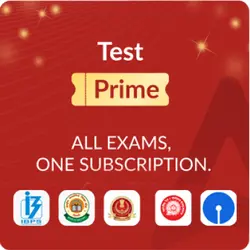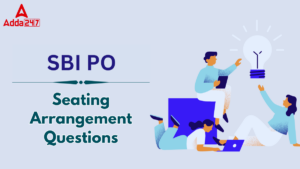Syllogism is an important part of logical reasoning that assesses the critical and analytical thinking skills of the candidate. It involves drawing a conclusion from the given statements, commonly known as the premises. Syllogism Questions for Bank Exams holds crucial importance in bank exams, making it essential for candidates to master it. With the 2025 bank exams approaching, it is time to sharpen your reasoning abilities and increase your accuracy in solving syllogism questions efficiently.
Syllogism Questions for Bank Exams
Syllogism questions are very important in the Reasoning Ability section of bank exams, holding vital importance. They come in different types, such as categorical, hypothetical and separative, each of which has a unique logical structure. Understanding these types helps candidates analyse the premise and draw accurate conclusions. This process can be simplified by visually representing relationships using Venn diagrams, making it easier to identify overlaps and exclusions.
Directions: In question, some statements are given, followed by two conclusions I and II.You have to consider the statements to be true, even if they seem to be at variance fromcommonly known facts. You have to decide which of the given conclusions, if any, follow from the given statements. Indicate your answer.
1. Statements: All tubes are cubes.
No cube is the sky.
No bird is the sky.
Conclusions: I. No tube is the bird.
II. All birds being cubes is a possibility.
A. If only conclusion I follow
B. If only conclusion II follow
C. If neither conclusion I nor conclusion II follows
D. If both the conclusions follow
E. If either conclusion I or conclusion II follows.
2. Statements: No dancers are actors.
Some actors are artists.
No artist is artisan.
Conclusions: I. Some artists are not dancers.
II. Some artisans are not actors.
A. If only conclusion I follow
B. If only conclusion II follow
C. If neither conclusion I nor conclusion II follows
D. If both the conclusions follow
E. If either conclusion I or conclusion II follows.
3. Statement: All rivers are seas.
All lakes are seas.
Some seas are not oceans.
Conclusions: I. Some rivers are not lakes.
II. Some oceans may not be seas.
A. If only conclusion I follow
B. If only conclusion II follow
C. If neither conclusion I nor conclusion II follows
D. If both the conclusions follow
E. If either conclusion I or conclusion II follows.
4. Statements: Some plates are knives.
Some knives are bottles.
Many bottles are bowls.
Conclusions: I. Some plates are bowls.
II. Not a single plate is a bowl.
A. If only conclusion I follow
B. If only conclusion II follow
C. If neither conclusion I nor conclusion II follows
D. If both the conclusions follow
E. If either conclusion I or conclusion II follows.
5. Statements: All radios are electric goods.
All table lamps are electric goods.
Conclusions: I. Some radios are table lamps.
II. Some table lamps are radios.
A. If only the conclusion I follow.
B. If only conclusion II follows.
C. If either I or II follows.
D. If neither I nor II follows.
E. If both I and II follow
6. Statements: No man is a monkey.
John is a man.
Conclusions: I. John is not a monkey.
II. John may or may not be a monkey.
A. If only the conclusion I follow.
B. If only conclusion II follows.
C. If either I or II follows.
D. If neither I nor II follows.
E. If both I and II follow
7. Statements: A graduate is a man.
This thief is a graduate.
Conclusions: I. This thief is a man.
II. Some men are thieves.
A. If only the conclusion I follow.
B. If only conclusion II follows.
C. If either I or II follows.
D. If neither I nor II follows.
E. If both I and II follow
8. Statements: Only first-divisioners are admitted.
Ram is a first-divisioner.
Conclusions: I. Ram is admitted.
II. Only Ram is admitted.
A. If only the conclusion I follow.
B. If only conclusion II follows.
C. If either I or II follows.
D. If neither I nor II follows.
E. If both I and II follow
9. Statements: Men are sinners.
Saints are men.
Conclusions: I. Saints are sinners.
II. Sinners are saints.
A. If only the conclusion I follow.
B. If only conclusion II follows.
C. If either I or II follows.
D. If neither I nor II follows.
E. If both I and II follow
10. Statements: No wire is pin.
Some pins are mugs.
Conclusions: I. All mugs being wires is a possibility.
II. Some mugs are not wires.
A. Only I follow
B. Only II follows
C. If either I or II follows
D. If neither I nor II follows
E. If both I and II follow
11. Statements: No water is air.
No fire is water.
Conclusions: I. No air is fire.
II. All fire is air.
A. if only the conclusion I follow.
B. if only conclusion II follows.
C. if either conclusion I or conclusion II follows.
D. if neither conclusion I nor conclusion II follows.
E. if both conclusion I and conclusion II follow.
12. Statements: Some balls are bats.
No bat is a wicket.
Conclusions: I. Some wickets are not ball.
II. All wickets being ball is a possibility.
A. if only the conclusion I follow.
B. if only conclusion II follows.
C. if either conclusion I or conclusion II follows.
D. if neither conclusion I nor conclusion II follows.
E. if both conclusion I and conclusion II follow.
13. Statement: All shirts are skirts.
No skirt is top.
All tops are kurta.
Conclusions: I. All shirts are kurta
II. Some kurta are skirts
A. If only conclusion I follow
B. If only conclusion II follow
C. If neither conclusion I nor conclusion II follows
D. If both the conclusions follow
E. If either conclusion I or conclusion II follows.
14. Statements: Some frooti are Maaza.
No Maaza is slice.
All slice are fanta.
Conclusions: I. Some frooti are definitely not slice.
II. Some fanta are definitely not Maaza.
A. If only conclusion I follow
B. If only conclusion II follow
C. If neither conclusion I nor conclusion II follows
D. If both the conclusions follow
E. If either conclusion I or conclusion II follows.
15. Statements: All carbon are oxygen.
All Nitrogen are carbon.
Some oxygen are Sulphur.
Conclusions: I. All Nitrogen being Sulphur is a possibility.
II. All Nitrogen are not oxygen.
A. If only conclusion I follow
B. If only conclusion II follow
C. If neither conclusion I nor conclusion II follows
D. If both the conclusions follow
E. If either conclusion I or conclusion II follows.
16. Statements: No month is a year.
Some years are weeks.
Conclusions: I. No weeks is a year.
II. Some weeks are years.
A. If only conclusion I follow
B. If only conclusion II follow
C. If neither conclusion I nor conclusion II follows
D. If both the conclusions follow
E. if either conclusion I or conclusion II follows.
17. Statements: No tea is sugar.
No milk is tea.
Conclusions: I. No sugar is milk.
II. All milk are sugar.
A. If only conclusion I follow
B. If only conclusion II follow
C. If neither conclusion I nor conclusion II follows
D. If both the conclusions follow
E. if either conclusion I or conclusion II follows.
18. Statements: Some chocolate are chips.
Some chips are jelly.
All jelly are whoppers.
Conclusions: I. Some jelly are chips.
II. All chocolate being whoppers is a possibility.
A. If only conclusion I follow
B. If only conclusion II follow
C. If neither conclusion I nor conclusion II follows
D. If both the conclusions follow
E. If either conclusion I or conclusion II follows.
19. Statements: Some mountains are oceans.
Some mountains are states.
All states are countries.
Conclusions: I. Some oceans are states.
II. All countries are oceans.
A. Only C1 follows.
B. Only C2 follows.
C. Both C1 and C2 follow.
D. Neither C1 nor C2 follows.
E. Either C1 or C2 follows.
20. Statements: Some Buildings are malls.
Some malls are markets.
All shops are markets.
Conclusions: I. Some markets are not malls.
II. All markets are malls.
A. Only C1 follows.
B. Only C2 follows
C. Both C1 and C2 follow.
D. Neither C1 nor C2 follows.
E. Either C1 or C2 follows.
Directions (21-25): In the question below, three statements are given followed by the conclusions. You have to take the given statements to be true even if they seem to be at variance with commonly known facts. Read all the conclusions and then decide which of the given conclusions logically follows from the given statements disregarding commonly known facts.
Q21. Statements: Only a few Peacocks are Ostrich.
Only a few Rats are Swans.
Some Swans are Peacocks.
Conclusions: I. Some Rats can be Ostrich.
II. All Swans being Ostrich is a possibility.
(a) Only I follows
(b) Only II follows
(c) Either I or II follows
(d) Neither I nor II follows
(e) Both I and II follow
Q22. Statements: All Boards are Tube lights.
Only a few Wires are Boards.
All Switches are Boards.
Conclusions: I. All wires being Switches is a possibility.
II. Some Switches being Wires is a possibility.
(a) Only I follows
(b) Only II follows
(c) Either I or II follows
(d) Neither I nor II follows
(e) Both I and II follow
Q23. Statements: Some Eagles are Pigeons.
Only a few Parrots are Eagles.
All Parrots are Peacocks.
Conclusions: I. Some Peacocks can be Pigeons.
II. No Eagles are Peacocks.
(a) Only I follows
(b) Only II follows
(c) Either I or II follows
(d) Neither I nor II follows
(e) Both I and II follow
Q24. Statements: All Cats are Dogs.
Only a few Dogs are Rabbits.
All Rabbits are Rats.
Conclusions: I. Some Cats are Rats.
II. No Cats are Rats.
(a) Only I follows
(b) Only II follows
(c) Either I or II follows
(d) Neither I nor II follows
(e) Both I and II follow
Q25. Statements: All Animals are foods.
Only a few Birds are Humans.
All foods are Humans.
Conclusions: I. Some Birds are not Humans.
II. No Animals are Humans.
(a) Only I follows
(b) Only II follows
(c) Either I or II follows
(d) Neither I nor II follows
(e) Both I and II follow
Directions (26-30): In each question below, some statements are given followed by some conclusions. You have to take the given statements to be true even if they seem to be at variance with commonly known facts. Read all the conclusions and then decide which of the given conclusions logically follows from the given statements, disregarding commonly known facts:
(a) Only I follow
(b) Only II follow
(c) Either I or II follow
(d) Neither I nor II follow
(e) Both I and II follows
Q26. Statements: Only a few Study is Research
No Study is Flower
All Food is Research
Conclusions: I. All Flower is Food is a possibility
II. Atleast some Food is study
Q27. Statements: All Blue is Grey
Only a few Olive is Grey
No Green is Blue
Conclusions: I. Some Green is Grey is a possibility
II. All Blue is Olive is a possibility
Q28. Statements: Only Apple is Mango
No Grapes is Apple
No Orange is Grapes
Conclusions: I. Some Apple is Orange
II. All Orange is Apple is a possibility
Q29. Statements: All Paper is Pen
All Pencil is Book
No Paper is Pencil
Conclusions: I. No Book is Paper
II. Some Pencil is Pen
Q30. Statements: Only a few Flower is Fruit
No Tree is Fruit
Some Green is Tree
Conclusions: I. No Green is Fruit
II. Some Fruit is Green
| Answers |
||
| 1-B | 11-D | 21-E |
| 2-A | 12-B | 22-B |
| 3-B | 13-C | 23-A |
| 4-E | 14-D | 24-C |
| 5-D | 15-A | 25-A |
| 6-A | 16-B | 26-A |
| 7-E | 17-C | 27-E |
| 8-D | 18-D | 28-B |
| 9-A | 19-D | 29-D |
| 10-B | 20-E | 30-C |




 Important Blood Relation Questions for S...
Important Blood Relation Questions for S...
 Seating Arrangement Questions for SBI PO...
Seating Arrangement Questions for SBI PO...
 Inequality Questions for Bank Exams
Inequality Questions for Bank Exams





